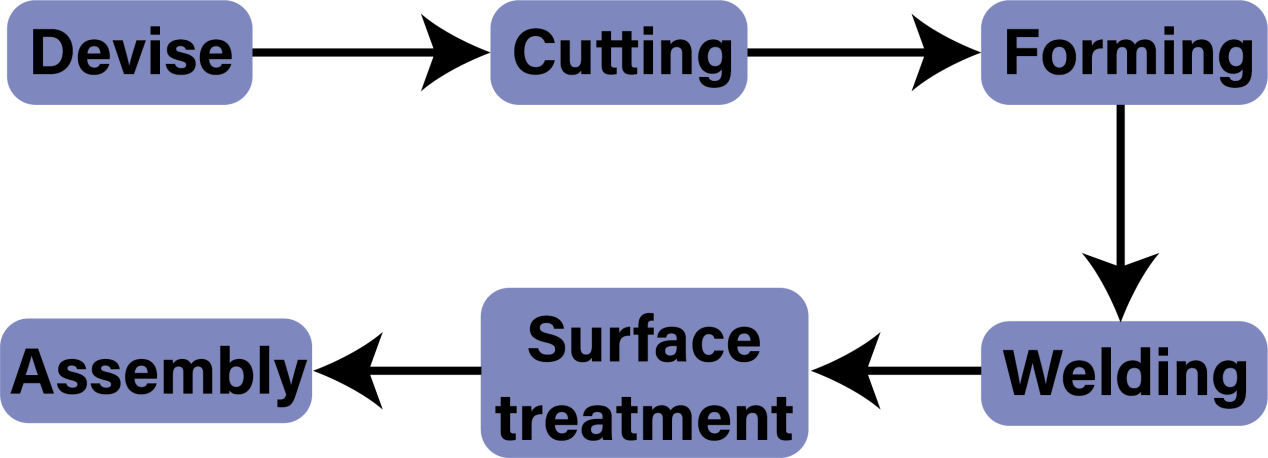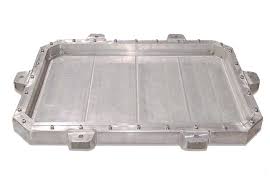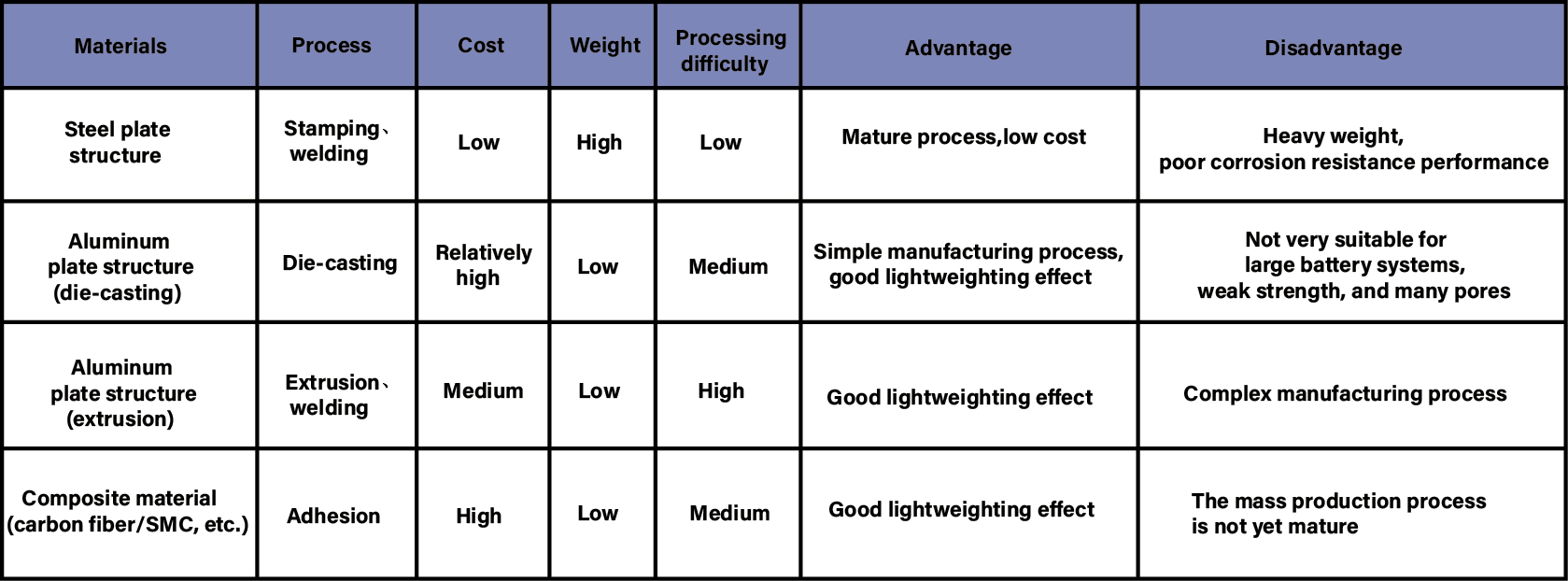
프로젝트 연락처:
Chris
+86 193-5550-1188
info@xdthermal.com
배터리 트레이는 새로운 에너지 차량의 전원 시스템의 필수 구성 요소로, 배터리를 지지하고 고정하며 보호하도록 특별히 설계되었습니다. 이를 통해 차량이나 에너지 저장 시스템에 안전하고 안정적으로 설치할 수 있습니다. 전기차 배터리 시스템의 안전에 중요한 역할을 하는 배터리 트레이는 고도로 맞춤화할 수 있습니다. 강력한 지지력, 방수, 방진, 화재 예방, 열 확산 제어 및 부식 방지 기능을 제공합니다.
초기에는 강철로 제작되었던 전기 자동차의 배터리 트레이는 더 가볍고 효율적인 금속 합금 디자인을 목표로 알루미늄 합금 트레이로 발전했습니다. 이러한 진화는 전기차가 기존 연료 차량보다 무겁고 주행 거리를 맞추기 위해 노력하기 때문에 더 가벼운 차량에 대한 필요성에 의해 주도되었습니다.

주로 고강도 강철로 제작된 스틸 배터리 트레이는 신에너지 자동차의 배터리 시스템에서 핵심적인 역할을 합니다.

장점:
비용 효율적: 제조업체에게 비용 이점을 제공합니다.
● 뛰어난 가공 및 용접 기능: 제조 프로세스를 간소화하고 유연성을 더합니다.
● 돌 충격에 대한 강한 내성: 다양한 도로 조건에 적응하여 배터리 안전성을 향상시킵니다.
단점:
● 더 무거운 무게: 주행 거리에 부정적인 영향을 미칩니다.
● 낮은 강성: 압력을 받으면 변형되기 쉬워 배터리가 손상되고 화재 위험이 높아질 수 있습니다.
● 내식성 저하: 내부 배터리 손상으로 이어짐
주조 알루미늄 배터리 트레이는 일반적으로 소형 에너지 배터리 팩에 사용되는 일체형 구조입니다.

장점:
● 일체형 몰딩 제조 프로세스를 간소화합니다.
● 유연한 디자인 옵션 를 사용하여 다양한 요구 사항을 충족하고 설계의 자유도를 높일 수 있습니다.
● 전반적으로 높은 기계적 성능 는 우수한 구조적 안정성을 보장합니다.
● 경량 디자인 전체 차량 중량을 줄여 주행 거리를 늘립니다.
● 용접 필요 없음를 사용하여 제품의 신뢰성과 내구성을 개선합니다.
단점:
● 제품 밀봉 불량: 언더캐스팅, 균열, 콜드 셧, 덴트, 다공성 등과 같은 결함이 발생하기 쉽습니다.
● 연신율이 낮고 충격 시 변형될 가능성이 높습니다.
● 대용량 배터리 트레이에는 적합하지 않음
압출 알루미늄 합금 배터리 트레이는 다양한 요구 사항을 충족하는 프로파일로 조립 및 가공된 인기 있는 디자인 옵션입니다.

장점:
유연한 디자인: 다양한 애플리케이션 요구 사항을 수용합니다.
편리한 처리: 생산 효율성을 향상시킵니다.
쉽게 수정할 수 있습니다: 다양한 배터리 크기와 차량 모델에 맞게 조정할 수 있습니다.
● 높은 강성: 배터리 부품에 필요한 강도와 안정성을 제공합니다.
내진동성: 다양한 도로 조건에서 배터리 안정성을 유지합니다.
압축과 충격에 강합니다: 배터리 구성품의 안전을 보장합니다.
단점:
● 복잡한 용접 프로세스: 여러 용접 지점을 포함하므로 복잡성이 증가합니다.
● 제조 난이도가 증가합니다.
● 더 높은 코스

압출 알루미늄 합금 배터리 트레이는 다양한 요구 사항을 충족하는 프로파일로 조립 및 가공된 인기 있는 디자인 옵션입니다.
장점:
유연한 디자인: 다양한 애플리케이션 요구 사항을 수용합니다.
편리한 처리: 생산 효율성을 향상시킵니다.
쉽게 수정할 수 있습니다: 다양한 배터리 크기와 차량 모델에 맞게 조정할 수 있습니다.
● 높은 강성: 배터리 부품에 필요한 강도와 안정성을 제공합니다.
내진동성: 다양한 도로 조건에서 배터리 안정성을 유지합니다.
압축과 충격에 강합니다: 배터리 구성품의 안전을 보장합니다.
단점:
● 복잡한 용접 프로세스: 여러 용접 지점을 포함하므로 복잡성이 증가합니다.
● 제조 난이도가 증가합니다.
● 더 높은 코스
배터리 트레이, 특히 압출 알루미늄 합금 트레이의 접합 기술은 크게 발전했습니다. 이제는 마찰 교반 용접(FSW), TIG, MIG, CMT와 같은 정교한 용접 기술과 볼팅과 같은 기계적 연결 방법을 사용합니다. 이러한 혁신은 배터리 트레이를 더욱 견고하고 안정적으로 제작하여 생산 효율성을 높이고 전기 자동차 개발을 강력하게 지원합니다.
마찰 교반 용접(FSW)은 고속으로 회전하는 공구가 마찰을 통해 열을 발생시켜 재료를 국부적으로 녹이는 핵심 방법입니다. 공구가 접합부를 따라 이동하면서 연화된 재료가 공구의 회전력에 의해 앞쪽에서 뒤쪽으로 흐르면서 조밀한 고체상 용접 이음새를 형성합니다.
장점:
● 공작물 변형 위험이 낮습니다.
● 높은 효율성: 긴 이음새, 넓은 단면, 다양한 위치에서 한 번에 용접할 수 있습니다.
● 편리한 운영: 기계화 및 자동화, 간단한 장비, 낮은 에너지 소비, 높은 효율성, 최소한의 환경 요구 사항을 충족할 수 있습니다.
● 저렴한 비용: 추가 용접 와이어가 필요 없고, 알루미늄 합금을 용접하기 전에 산화막을 제거할 필요가 없으며, 보호 가스가 필요하지 않습니다.
● 다양한 재료를 용접할 수 있습니다.
● 안전한 프로세스: 오염, 연기, 방사능으로부터 자유롭습니다.
단점:
● 공작물은 받침판으로 단단히 고정해야 합니다.
● 용접 이음새를 수리하기 어렵습니다.
● 공구 설계, 공정 파라미터 및 기계적 성능 데이터는 좁은 범위의 합금으로 제한됩니다.
● 내식성, 잔류 응력 및 변형을 고려한 특수 영역의 성능 개선이 필요했습니다.
● 용접 속도는 그리 높지 않습니다.
● 교반 헤드의 빠른 마모.
배터리 트레이의 프레임을 연결하는 데 자주 사용되는 퓨전 용접은 마찰 교반 용접이 실용적이지 않은 프레임 모서리에서 특히 필요합니다. 이 공정에는 일반적으로 TIG, MIG, CMT와 같은 방법이 사용되며 모서리 접합부에는 아크 용접이 포함됩니다.
장점:
● 광범위한 적용: 프레임 모서리 용접에 이상적입니다.
● 높은 적응성: 특히 강철 배터리 트레이에 적합합니다.
단점:
● 열 입력 증가: 이로 인해 용접 강도가 저하될 수 있습니다.
● 변형의 위험.
● 다공성 문제: 트레이에서 잠재적인 누출이 발생할 수 있습니다.
볼트 연결은 볼트와 너트를 사용하여 구성 요소를 결합하는 기계적 고정 방식으로, 일반적으로 잦은 분해와 교체가 필요한 경우에 사용됩니다. 기본 원리는 구성 요소 구멍에 볼트를 통과시키고 너트로 고정하여 단단하고 안정적인 연결을 달성하는 것입니다.
장점:
● 분해가 간편합니다: 정기적인 유지보수가 필요한 부품에 이상적입니다.
● 매우 유연합니다: 다양한 크기와 모양의 구성 요소에 적합합니다.
단점:
● 느슨해지기 쉽습니다: 볼트 연결은 시간이 지나면 느슨해질 수 있습니다.
● 정기적인 점검이 필요합니다: 유지 관리 작업량이 증가합니다.
리벳팅은 리벳과 리벳 너트를 사용하여 두 개 이상의 부품을 영구적으로 연결하는 기계적 결합 방식입니다. 이 과정에서 부품의 구멍을 통해 리벳이 삽입되고 리벳 너트가 압축되어 팽창하면서 강력한 접합부가 만들어집니다.
장점:
자주 교체하지 않는 부품의 경우 비교적 쉽게 분해할 수 있습니다.
● 눈에 띄는 실이나 돌출부가 없는 깔끔한 외관.
단점:
작동 중 느슨해질 수 있습니다.
● 정기적인 유지보수 및 점검이 필요합니다.


새로운 에너지 차량에서 배터리 인클로저의 진화는 증가하는 환경 및 효율성 요구에 대한 전략적 적응입니다. 처음에는 단순성과 비용 때문에 강철을 선호했던 업계는 더 가벼운 알루미늄 합금과 첨단 제조 기술로 전환하고 있습니다. 이러한 변화는 지속 가능한 운송을 지향하는 세계적인 추세와도 맞닿아 있습니다. 2030년까지 신에너지 자동차 판매량이 약 5,200만 대에 달할 것이라는 예측이 나오면서 배터리 트레이 시장도 이에 따라 급성장하고 있습니다. 이러한 성장은 기술 발전뿐만 아니라 지속 가능한 자동차 솔루션에 대한 광범위한 노력을 반영하며, 증가하는 글로벌 수요를 충족하기 위해 배터리 인클로저 설계 및 생산의 혁신을 주도하고 있습니다.